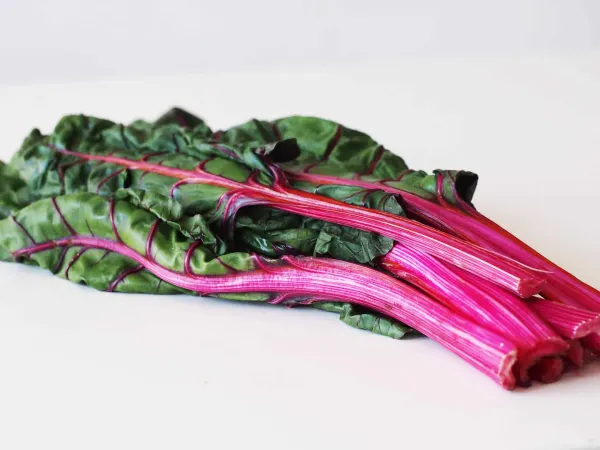Swiss Chard
Vegetable
Age Suggestion
6 months
Iron-Rich
Yes
Common Allergen
No

When can babies have swiss chard?
Swiss chard may be introduced as soon as baby is ready to start solids, which is generally around 6 months of age.
Swiss chard is a nutritious leafy green in the same plant family as spinach and beets, whose edible leaves are also packed with vitamins and minerals and often used in place of swiss chard. In American English, chard was supposedly given the “Swiss” label to distinguish the leafy green from spinach. Yet despite what this name implies, the plant originated in the sandy soil on the coasts of the Mediterranean Sea. Trade brought the plant to northern regions of Europe and eventually to other parts of the world, where it is called acelga (Spanish), bettes (French), mangold (German and Russian), and silverbeet (Australian English).
Is swiss chard healthy for babies?
Yes. Swiss chard is packed with vitamin K, an essential nutrient to help develop healthy blood and bones in growing babies and toddlers. The leafy green is also a great source of vitamin A for healthy vision and vitamin E for a healthy immune system. Plus it offers good amounts of iron, fiber, vitamins B and C; minerals like calcium, magnesium, and potassium; and plant nutrients that help fight free radicals and inflammation within the body.
★Tip: Wash swiss chard before cooking or serving. Raw swiss chard and other leafy greens can be a higher risk food for E. coli infection, and washing can reduce the risk of illness.
Is swiss chard a common allergen?
No. Allergies to swiss chard are rare, but they have been reported. Individuals with Oral Allergy Syndrome (also known as pollen food allergy syndrome), in particular those who are allergic to grass and mugwort pollens, may also be sensitive to swiss chard. Oral Allergy Syndrome typically results in short-lived itching or burning in the mouth and is unlikely to result in a dangerous reaction. Cooking swiss chard can minimize the reaction.
As you would when introducing any new food, start by offering a small amount for the first few servings. If there is no adverse reaction, gradually increase the amount served over future meals.
Is swiss chard a choking hazard for babies?
Yes. While the leafy parts of swiss chard do not pose a high choking risk, the stalks can be firm and challenging to chew, qualities that increase the risk of choking. To reduce the risk, prepare and serve swiss chard in an age-appropriate way. Note also that flecks of raw or cooked swiss chard can stick to baby’s tongue or the roof of the mouth, causing some harmless gagging. As always, make sure you create a safe eating environment and stay within an arm’s reach of baby during meals.
Learn the signs of choking and gagging and more about choking first aid in our free guides, Infant Rescue and Toddler Rescue.
Videos
Do I need to worry about nitrates in swiss chard?
No, there is no need to worry. You may have heard that swiss chard and other vegetables (like arugula, beets, carrots, lettuce, spinach, and squash to name a few) contain nitrates, which are naturally-occurring compounds which, if consumed in large amounts, may negatively affect oxygen levels in the blood. Babies younger than 3 months of age and/or those with health concerns may be more susceptible to the effects of nitrates. Organizations such as the American Academy of Pediatrics and the European Food Safety Authority view nitrates in vegetables as generally not a concern for most healthy children and that the benefits of eating these vegetables as part of a varied diet typically outweigh the risks of excess nitrate exposure.
How do you serve swiss chard to babies?
Every baby develops on their own timeline, and the suggestions on how to cut or prepare particular foods are generalizations for a broad audience.
6 months old +:
Mix cooked and finely chopped swiss chard into finger food like frittata strips or soft foods that are easy for baby to scoop, like grain porridges, mashed vegetables, or yogurt. Alternatively, you can serve a whole stalk (cooked until soft, with the leafy parts removed) for baby to munch on like a teether. If baby manages to break off a piece of chard stalk, give baby a moment to either chew and swallow it or spit it out, keeping your fingers out of baby’s mouth. You can help by putting your hand on baby’s back and gently leaning the baby forward to allow gravity to help pull the piece of food towards the front of the mouth for baby to more easily spit out.
9 months old +:
At this age, babies start to develop the pincer grasp (where the thumb and pointer finger meet), which enables them to pick up smaller pieces of food. Once baby shows signs that this development is underway, try offering chopped pieces or small ribbons of swiss chard (leaves and stalk) that have been cooked until soft. Alternatively, continue to stir finely chopped and cooked swiss chard into age-appropriate foods. If serving bite-sized pieces or small ribbons of swiss chard, know that the pieces of the leaf can stick inside baby’s mouth and cause some harmless gagging.
24 months old +:
Offer cooked and chopped swiss chard on its own or stir into cooked dishes and scoopable foods. As the child’s chewing skills become more coordinated and you gain confidence in their ability to chew and move the food backwards to swallow as well as chew and spit out food, you may start to serve larger pieces of cooked or raw swiss chard, including raw pieces of the stalk, which poses a higher choking risk than the leaf. Expect the child to chew and spit out the food at first before beginning to more consistently chew and swallow.
Spice up your dinner rotation with a new dish or two from our 100 Dinners for Babies & Toddlers.
Our Team
Written by
Expert Tips Delivered to Your Inbox
Sign up for weekly tips, recipes and more!
Copyright © 2024 • Solid Starts Inc





